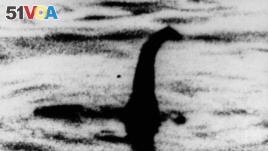09 September, 2019
Scotland's famous Loch Ness monster could possibly be a large eel, scientists announced last week. The scientists made the announcement after they completed a study of genetic material from the Loch's cold waters.
Deoxyribonucleic acid, or DNA, is a substance found in the cells of plants and animals. DNA is made up of genes, which carry a huge amount of information.
The scientists said their DNA results ruled out the presence of large animals such as dinosaurs. But there was a lot of eel DNA in the water, said Neil Gemmell, a geneticist from the University of Otago in New Zealand.

FILE -An undated photo shows a shadowy shape that some people say is the Loch Ness monster in Scotland.
"We don't know whether these samples we've collected are from a giant beast or just an ordinary one - so there's still this element of ‘we just don't know,'" he said.
Gemmell noted, however, that nobody had ever caught something as big as a giant eel in the Loch. Eels are long, bony fish that look like snakes. They are usually thin and have soft skin.
The international team of scientists collected water samples of what they are calling environmental DNA, or eDNA. Scientists have also used eDNA sampling as a tool to study sea life like whales and sharks.
The Reuters news agency describes how eDNA works: Whenever a creature moves through its environment, it leaves behind very small amounts of DNA from skin, scales, hair and waste. Scientists can capture the DNA, then try to identify the order of the genetic information. They can identify an animal by comparing the captured DNA to large computer databases.
The Loch Ness monster has a long history.
Saint Columba, a member of a Christian religious community, is said to have banished a "water beast" to the bottom of the River Ness in the 6th century.
The most famous picture of the Loch Ness monster was taken in 1934. It shows a head on a long neck coming out of the water.
This photograph is known as the "surgeon's photo." It was a hoax. Investigators said it actually shows a model of a sea monster connected to a child's toy submarine.
There have been many unsuccessful attempts to find the Loch Ness monster.
In 2003, the British Broadcasting Corporation paid for scientific research that used sonar beams and satellites to study the full length of the loch.
The most recent attempt was three years ago. An unmanned vehicle found a creature, but not the one it was looking for. The discovery was, in fact, a model used in the 1970 film "The Private Life of Sherlock Holmes." It sank nearly 50 years ago.
I'm John Russell.
Makenzie Katz reported on this story for the Reuters news agency. John Russell adapted it for VOA Learning English. George Grow was the editor.
_____
Words in the Story
beast – n. an especially large or dangerous animal
ordinary – adj. average; not special
sample – v. to test, study, or question something to get information
scale – n. one of many small thin plates that cover the bodies of some animals (such as fish or snakes)
database – n. a set of information of records kept on computers
banish - v. to cause (something) to go away
hoax – n. an act that is meant to trick people
sonar beam – n. sound waves, or beams of sound, that show where things are underwater
We want to hear from you. Write to us in the Comments Section.













